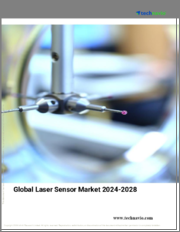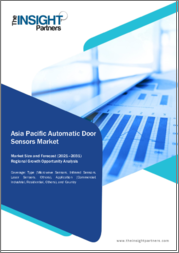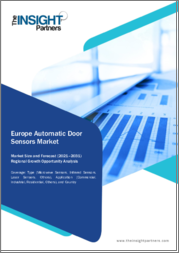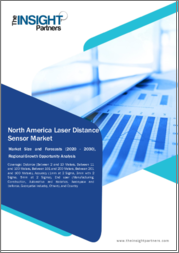
|
시장보고서
상품코드
1831851
레이저 센서 시장 보고서 : 유형, 컴포넌트, 용도, 최종사용자, 지역별(2025-2033년)Laser Sensor Market Report by Type, Component, Application, End User, and Region 2025-2033 |
||||||
세계의 레이저 센서 시장 규모는 2024년에 7억 9,640만 달러에 달했습니다. 향후 IMARC Group은 시장이 2033년까지 17억 820만 달러에 달하며, 2025-2033년의 성장률(CAGR)은 8.41%를 보일 것으로 예측하고 있습니다. 이 시장은 제조업의 자동화 발전, 센서 기술의 급속한 발전, 재생에너지 분야에서의 적용 확대, 고정밀 측정에 대한 수요 증가, 연구개발(R&D)에 대한 투자 증가 등을 배경으로 강력한 성장세를 보이고 있습니다.
레이저 센서 시장 동향
제조업의 자동화 도입 확대
제조 공정의 자동화가 진행되고 있는 것은 레이저 센서 시장의 성장을 가속하는 중요한 요인 중 하나입니다. 현대 산업시설에서는 생산성, 정확성, 효율성을 높이기 위해 자동화 기술이 주로 사용되고 있습니다. 제조업체의 63% 이상이 생산 공정에 자동화 기술을 도입하고 있습니다. 그 중 75%의 기업은 생산성이 10-12% 향상되었다고 보고했습니다. 또한 제조업의 자동화를 통해 폐기물을 최대 30%까지 줄일 수 있는 것으로 나타났습니다. 또한 다운타임을 최대 20%까지 줄일 수 있습니다. 레이저 센서는 정확성과 신뢰성으로 유명하며, 고도로 자동화된 상황에서 필수적입니다. 레이저 센서는 측정, 위치 결정, 품질관리 등 다양한 용도로 활용되고 있습니다. 이러한 센서는 부품의 정확한 위치 결정과 조립을 보장하는 데 필수적입니다.
레이저 센서 기술의 발전
레이저 센서 기술의 발전도 시장을 촉진하는 요인 중 하나입니다. 레이저 센서의 성능, 정확도, 범용성을 크게 향상시키는 지속적인 연구개발(R&D)은 레이저 센서 산업의 확장을 촉진하고 있습니다. 소형화, 감도 향상, 열악한 환경에서의 작동 능력과 같은 혁신적인 기술로 인해 다양한 산업 분야에서 센서의 적용 범위가 확대되고 있습니다. 예를 들어 키엔스는 제조상 과제에 대응하기 위해 센서 헤드의 설치와 프로그램 설정을 쉽게 할 수 있는 초소형 동축 레이저 변위 센서 CL-3000 시리즈를 출시했습니다. 또한 옴론은 소형 레이저 스폿형 공초점 광섬유 변위 센서 ZX-5000을 출시했습니다. ZX-5000은 기존 대비 1/5의 레이저 스폿 사이즈를 실현한 센서 헤드를 탑재하여 미세 부품의 고정밀 틈새, 위치, 형태 측정이 가능한 비접촉식 변위 센서입니다.
재생에너지로 넓어지는 용도
재생에너지 분야에서는 풍력 터빈 모니터링, 태양전지판 정렬, 바이오매스 측정 등 다양한 분야에서 레이저 센서가 사용되고 있습니다. 지속가능한 에너지원으로의 전환과 재생에너지 프로젝트에 대한 투자 증가로 인해 성능과 효율성을 최적화하는 첨단 센서 기술의 필요성이 부각되고 있습니다. 업계 보고서에 따르면 2023년 상반기 재생에너지에 대한 신규 투자가 3,580억 달러로 급증했습니다. 재생에너지 기업도 2023년 상반기 약정액이 104억 달러에 달하고, 2022년 상반기 대비 25% 증가하면서 성장과 확장을 지원하기 위한 주식 조달에 성공했습니다. 이러한 확장으로 인해 에너지 시스템 모니터링 및 제어에 필수적인 정밀 데이터를 제공하는 것으로 알려진 레이저 센서의 활용이 증가하고 있습니다.
목차
제1장 서문
제2장 조사 범위와 조사 방법
- 조사의 목적
- 이해관계자
- 데이터 소스
- 1차 정보
- 2차 정보
- 시장 추정
- 보텀업 어프로치
- 톱다운 어프로치
- 조사 방법
제3장 개요
제4장 서론
제5장 세계의 레이저 센서 시장
- 시장 개요
- 시장 실적
- COVID-19의 영향
- 시장 예측
제6장 시장 내역 : 유형별
- 컴팩트
- 초컴팩트
제7장 시장 내역 : 컴포넌트별
- 하드웨어와 소프트웨어
- 서비스
제8장 시장 내역 : 용도별
- 보안과 모니터링
- 모션과 가이던스
- 프로세스 모니터링과 품질관리
- 거리 측정
- 제조 공장 관리
- 기타
제9장 시장 내역 : 최종사용자별
- 자동차
- 항공우주와 방위
- 식품 및 음료
- 가전제품
- 화학제품
- 헬스케어
- 기타
제10장 시장 내역 : 지역별
- 북미
- 미국
- 캐나다
- 아시아태평양
- 중국
- 일본
- 인도
- 한국
- 호주
- 인도네시아
- 기타
- 유럽
- 독일
- 프랑스
- 영국
- 이탈리아
- 스페인
- 러시아
- 기타
- 라틴아메리카
- 브라질
- 멕시코
- 기타
- 중동 및 아프리카
제11장 SWOT 분석
제12장 밸류체인 분석
제13장 Porter's Five Forces 분석
제14장 가격 분석
제15장 경쟁 구도
- 시장 구조
- 주요 기업
- 주요 기업의 개요
- Baumer Electric AG
- First Sensor AG(TE Connectivity Ltd.)
- IFM Electronic GmbH
- Keyence Corporation
- Laser Technology Inc.
- Micro-Epsilon Messtechnik GmbH & Co. KG
- MTI Instruments Inc.(Mechanical Technology Incorporated)
- OMRON Corporation
- Optex Co. Ltd.
- Panasonic Corporation
- Rockwell Automation Inc.
- Schmitt Industries Inc
- SmartRay GmbH
The global laser sensor market size reached USD 796.4 Million in 2024. Looking forward, IMARC Group expects the market to reach USD 1,708.2 Million by 2033, exhibiting a growth rate (CAGR) of 8.41% during 2025-2033. The market is experiencing robust growth, driven by the increasing automation in manufacturing, rapid advancements in sensor technology, expanding applications in the renewable energy sector, rising demand for high-precision measurement, and the heightened investments in research and development (R&D).
Laser Sensor Market Trends:
Growing Adoption of Automation in Manufacturing
The increasing automation of manufacturing processes is one of the key factors propelling the laser sensor market growth. Modern industrial facilities are majorly using automated technology to boost productivity, accuracy, and efficiency. Over 63% of manufacturers have integrated automation technologies into their production processes. Of which, 75% of businesses reported a 10-12% boost in productivity. It has also been discovered that automation in manufacturing can minimize waste by up to 30%. Additionally, it cuts downtime by up to 20%. Laser sensors are renowned for their accuracy and dependability, which are essential in highly automated situations. They are utilized in a variety of applications, including measuring, positioning, and quality control. These sensors are critical for ensuring that components are precisely positioned and assembled.
Advancements in Laser Sensor Technology
Advancements in laser sensor technology is another key driver of the market. The continuous research and development (R&D) efforts, which are leading to significant improvements in the performance, accuracy, and versatility of laser sensors, are propelling the laser sensor industry expansion. There have been innovations, such as miniaturization, enhanced sensitivity, and the ability to operate in harsh environments that have expanded the application scope of these sensors across various industries. For example, KEYENCE launched CL-3000 series ultra-compact coaxial laser displacement sensors to address manufacturing challenges and provide simple sensor head installation and program settings. In addition, OMRON launched a ZX-5000 small laser spot-type confocal fiber displacement sensor. By incorporating a sensor head that produces a laser spot size 1/5 that of a conventional model, the ZX-5000 non-contact displacement sensor performs high-precision gap, position, and profile measurement of micro components.
Expanding Applications in Renewable Energy
Laser sensors are used in the renewable energy sector for various applications, including wind turbine monitoring, solar panel alignment, and biomass measurement. There has been a shift towards sustainable energy sources, along with increasing investments in renewable energy projects that have highlighted the need for advanced sensor technologies to optimize performance and efficiency. As per industry reports, new investment in renewable energy skyrocketed to $358 billion in the first six months of 2023, which is a 22% rise compared to the start of 2022 and an all-time high for any six months. Renewable energy companies have also had success in the same year, raising equity to support their growth and expansion as their commitments reached $10.4 billion in 1H 2023, up 25% from 1H 2022. This expansion has increased the use of laser sensors as they are known to provide precise data that is critical for monitoring and controlling these energy systems.
Laser Sensor Market Segmentation:
Breakup by Type:
- Compact
- Ultra-Compact
Compact accounts for the majority of the market share
As per the laser sensor market trends and analysis, compact sensors accounted for the largest market share, driven by their versatility, ease of integration, and wide range of applications. They are highly favored in industries such as consumer electronics, automotive, and medical devices due to their small size, high accuracy, and ability to fit into constrained spaces without compromising performance. Moreover, their growing adoption in emerging technologies, such as wearable devices and smart home systems, owing to their critical role in enhancing functionality and efficiency across various applications, is positively impacting the laser sensor market revenue.
Breakup by Component:
- Hardware and Software
- Services
Hardware and software hold the largest share of the industry
Based on the laser sensor market segmentation and forecast, hardware and software accounted for the largest market segment. The critical interplay between the physical components of laser sensors and the accompanying software that enables data processing, analysis, and integration into broader systems is enhancing the market growth. Hardware components such as laser diodes, photodetectors, and signal processors provide the foundational capabilities for precise measurement and detection. At the same time, advanced software algorithms enhance these capabilities by enabling real-time data processing, calibration, and interpretation.
Breakup by Application:
- Security and Surveillance
- Motion and Guidance
- Process Monitoring and Quality Control
- Distance Measurement
- Manufacturing Plant Management
- Others
Security and surveillance represent the leading market segment
According to the laser sensor market overview and research report, security and surveillance accounted for the largest segment. The increasing need for advanced security solutions in various settings, such as commercial buildings, public spaces, critical infrastructure, and residential areas, is boosting the market growth. Laser sensors provide high-precision detection and monitoring capabilities that are essential for effective perimeter security, intrusion detection, and surveillance systems. Moreover, their ability to operate reliably in various environmental conditions and deliver accurate real-time data is creating a positive outlook for the laser sensor market share and value.
Breakup by End User:
- Automotive
- Aerospace and Defense
- Food and Beverages
- Consumer Electronics
- Chemical
- Healthcare
- Others
Food and beverages exhibit a clear dominance in the market
Based on the laser sensor market outlook and report, the food and beverages (F&B) sector accounted for the largest market share. The increasing importance of laser sensors in ensuring quality, safety, and efficiency in (F&B) production processes is favoring the market growth. Moreover, they are extensively used for applications such as level measurement, quality inspection, packaging verification, and sorting. Moreover, their growing popularity owing to their precision and reliability, which enables the detection of contaminants, measurement of fill levels, and verification of package integrity, is positively impacting the laser sensor market size.
Breakup by Region:
- North America
- United States
- Canada
- Asia-Pacific
- China
- Japan
- India
- South Korea
- Australia
- Indonesia
- Others
- Europe
- Germany
- France
- United Kingdom
- Italy
- Spain
- Russia
- Others
- Latin America
- Brazil
- Mexico
- Others
- Middle East and Africa
North America leads the market, accounting for the largest laser sensor market share
The report has also provided a comprehensive analysis of all the major regional markets, which include North America (the United States and Canada); Asia Pacific (China, Japan, India, South Korea, Australia, Indonesia, and others); Europe (Germany, France, the United Kingdom, Italy, Spain, Russia, and others); Latin America (Brazil, Mexico, and others); and the Middle East and Africa. According to the report, North America represents the largest regional market for laser sensor.
North America constituted the largest market share, driven by its advanced technological infrastructure, strong presence of key industry players, and significant investments in research and development (R&D). Moreover, the robust industrial base, particularly in the automotive, aerospace, healthcare, and manufacturing sectors, boosting the demand for high-precision and reliable laser sensors, is catalyzing the market growth. Additionally, the increasing adoption of automation and smart technologies in these industries is propelling the laser sensor demand. Furthermore, the imposition of stringent safety and quality regulations, contributing to the widespread use of these sensors for compliance and quality assurance purposes, is bolstering the market growth.
Competitive Landscape:
- The market research report has also provided a comprehensive analysis of the competitive landscape in the market. Detailed profiles of all major companies have also been provided. Some of the major market players in the laser sensor industry include Baumer Electric AG, First Sensor AG (TE Connectivity Ltd.), IFM Electronic GmbH, Keyence Corporation, Laser Technology Inc., Micro-Epsilon Messtechnik GmbH & Co. KG, MTI Instruments Inc. (Mechanical Technology Incorporated), OMRON Corporation, Optex Co. Ltd., Panasonic Corporation, Rockwell Automation Inc., Schmitt Industries Inc, SmartRay GmbH., etc.
- The major laser sensor companies are engaging in strategic initiatives to strengthen their market positions and drive innovation. They are investing in research and development (R&D) to enhance sensor accuracy, miniaturization, and robustness, catering to the evolving demands of various industries such as automotive, healthcare, and industrial automation. Moreover, leading players are forming collaborations and partnerships with technology firms and research institutions to integrate advanced technologies like artificial intelligence (AI) and the Internet of Things (IoT) with laser sensors for smarter and more efficient solutions. Additionally, they are focusing on expanding their product portfolios and geographical reach through acquisitions and the establishment of new production facilities in emerging markets.
Key Questions Answered in This Report:
- How has the global laser sensor market performed so far, and how will it perform in the coming years?
- What are the drivers, restraints, and opportunities in the global laser sensor market?
- What is the impact of each driver, restraint, and opportunity on the global laser sensor market?
- What are the key regional markets?
- Which countries represent the most attractive laser sensor market?
- What is the breakup of the market based on the type?
- Which is the most attractive type in the laser sensor market?
- What is the breakup of the market based on the component?
- Which is the most attractive component in the laser sensor market?
- What is the breakup of the market based on the application?
- Which is the most attractive application in the laser sensor market?
- What is the breakup of the market based on the end user?
- Which is the most attractive end user in the laser sensor market?
- What is the competitive structure of the market?
- Who are the key players/companies in the global laser sensor market?
Table of Contents
1 Preface
2 Scope and Methodology
- 2.1 Objectives of the Study
- 2.2 Stakeholders
- 2.3 Data Sources
- 2.3.1 Primary Sources
- 2.3.2 Secondary Sources
- 2.4 Market Estimation
- 2.4.1 Bottom-Up Approach
- 2.4.2 Top-Down Approach
- 2.5 Forecasting Methodology
3 Executive Summary
4 Introduction
- 4.1 Overview
- 4.2 Key Industry Trends
5 Global Laser Sensor Market
- 5.1 Market Overview
- 5.2 Market Performance
- 5.3 Impact of COVID-19
- 5.4 Market Forecast
6 Market Breakup by Type
- 6.1 Compact
- 6.1.1 Market Trends
- 6.1.2 Market Forecast
- 6.2 Ultra-Compact
- 6.2.1 Market Trends
- 6.2.2 Market Forecast
7 Market Breakup by Component
- 7.1 Hardware and Software
- 7.1.1 Market Trends
- 7.1.2 Market Forecast
- 7.2 Services
- 7.2.1 Market Trends
- 7.2.2 Market Forecast
8 Market Breakup by Application
- 8.1 Security and Surveillance
- 8.1.1 Market Trends
- 8.1.2 Market Forecast
- 8.2 Motion and Guidance
- 8.2.1 Market Trends
- 8.2.2 Market Forecast
- 8.3 Process Monitoring and Quality Control
- 8.3.1 Market Trends
- 8.3.2 Market Forecast
- 8.4 Distance Measurement
- 8.4.1 Market Trends
- 8.4.2 Market Forecast
- 8.5 Manufacturing Plant Management
- 8.5.1 Market Trends
- 8.5.2 Market Forecast
- 8.6 Others
- 8.6.1 Market Trends
- 8.6.2 Market Forecast
9 Market Breakup by End User
- 9.1 Automotive
- 9.1.1 Market Trends
- 9.1.2 Market Forecast
- 9.2 Aerospace and Defense
- 9.2.1 Market Trends
- 9.2.2 Market Forecast
- 9.3 Food and Beverages
- 9.3.1 Market Trends
- 9.3.2 Market Forecast
- 9.4 Consumer Electronics
- 9.4.1 Market Trends
- 9.4.2 Market Forecast
- 9.5 Chemical
- 9.5.1 Market Trends
- 9.5.2 Market Forecast
- 9.6 Healthcare
- 9.6.1 Market Trends
- 9.6.2 Market Forecast
- 9.7 Others
- 9.7.1 Market Trends
- 9.7.2 Market Forecast
10 Market Breakup by Region
- 10.1 North America
- 10.1.1 United States
- 10.1.1.1 Market Trends
- 10.1.1.2 Market Forecast
- 10.1.2 Canada
- 10.1.2.1 Market Trends
- 10.1.2.2 Market Forecast
- 10.1.1 United States
- 10.2 Asia-Pacific
- 10.2.1 China
- 10.2.1.1 Market Trends
- 10.2.1.2 Market Forecast
- 10.2.2 Japan
- 10.2.2.1 Market Trends
- 10.2.2.2 Market Forecast
- 10.2.3 India
- 10.2.3.1 Market Trends
- 10.2.3.2 Market Forecast
- 10.2.4 South Korea
- 10.2.4.1 Market Trends
- 10.2.4.2 Market Forecast
- 10.2.5 Australia
- 10.2.5.1 Market Trends
- 10.2.5.2 Market Forecast
- 10.2.6 Indonesia
- 10.2.6.1 Market Trends
- 10.2.6.2 Market Forecast
- 10.2.7 Others
- 10.2.7.1 Market Trends
- 10.2.7.2 Market Forecast
- 10.2.1 China
- 10.3 Europe
- 10.3.1 Germany
- 10.3.1.1 Market Trends
- 10.3.1.2 Market Forecast
- 10.3.2 France
- 10.3.2.1 Market Trends
- 10.3.2.2 Market Forecast
- 10.3.3 United Kingdom
- 10.3.3.1 Market Trends
- 10.3.3.2 Market Forecast
- 10.3.4 Italy
- 10.3.4.1 Market Trends
- 10.3.4.2 Market Forecast
- 10.3.5 Spain
- 10.3.5.1 Market Trends
- 10.3.5.2 Market Forecast
- 10.3.6 Russia
- 10.3.6.1 Market Trends
- 10.3.6.2 Market Forecast
- 10.3.7 Others
- 10.3.7.1 Market Trends
- 10.3.7.2 Market Forecast
- 10.3.1 Germany
- 10.4 Latin America
- 10.4.1 Brazil
- 10.4.1.1 Market Trends
- 10.4.1.2 Market Forecast
- 10.4.2 Mexico
- 10.4.2.1 Market Trends
- 10.4.2.2 Market Forecast
- 10.4.3 Others
- 10.4.3.1 Market Trends
- 10.4.3.2 Market Forecast
- 10.4.1 Brazil
- 10.5 Middle East and Africa
- 10.5.1 Market Trends
- 10.5.2 Market Breakup by Country
- 10.5.3 Market Forecast
11 SWOT Analysis
- 11.1 Overview
- 11.2 Strengths
- 11.3 Weaknesses
- 11.4 Opportunities
- 11.5 Threats
12 Value Chain Analysis
13 Porters Five Forces Analysis
- 13.1 Overview
- 13.2 Bargaining Power of Buyers
- 13.3 Bargaining Power of Suppliers
- 13.4 Degree of Competition
- 13.5 Threat of New Entrants
- 13.6 Threat of Substitutes
14 Price Analysis
15 Competitive Landscape
- 15.1 Market Structure
- 15.2 Key Players
- 15.3 Profiles of Key Players
- 15.3.1 Baumer Electric AG
- 15.3.1.1 Company Overview
- 15.3.1.2 Product Portfolio
- 15.3.2 First Sensor AG (TE Connectivity Ltd.)
- 15.3.2.1 Company Overview
- 15.3.2.2 Product Portfolio
- 15.3.2.3 Financials
- 15.3.3 IFM Electronic GmbH
- 15.3.3.1 Company Overview
- 15.3.3.2 Product Portfolio
- 15.3.4 Keyence Corporation
- 15.3.4.1 Company Overview
- 15.3.4.2 Product Portfolio
- 15.3.4.3 Financials
- 15.3.5 Laser Technology Inc.
- 15.3.5.1 Company Overview
- 15.3.5.2 Product Portfolio
- 15.3.6 Micro-Epsilon Messtechnik GmbH & Co. KG
- 15.3.6.1 Company Overview
- 15.3.6.2 Product Portfolio
- 15.3.7 MTI Instruments Inc. (Mechanical Technology Incorporated)
- 15.3.7.1 Company Overview
- 15.3.7.2 Product Portfolio
- 15.3.8 OMRON Corporation
- 15.3.8.1 Company Overview
- 15.3.8.2 Product Portfolio
- 15.3.8.3 Financials
- 15.3.8.4 SWOT Analysis
- 15.3.9 Optex Co. Ltd.
- 15.3.9.1 Company Overview
- 15.3.9.2 Product Portfolio
- 15.3.9.3 Financials
- 15.3.10 Panasonic Corporation
- 15.3.10.1 Company Overview
- 15.3.10.2 Product Portfolio
- 15.3.10.3 Financials
- 15.3.10.4 SWOT Analysis
- 15.3.11 Rockwell Automation Inc.
- 15.3.11.1 Company Overview
- 15.3.11.2 Product Portfolio
- 15.3.11.3 Financials
- 15.3.11.4 SWOT Analysis
- 15.3.12 Schmitt Industries Inc
- 15.3.12.1 Company Overview
- 15.3.12.2 Product Portfolio
- 15.3.12.3 Financials
- 15.3.13 SmartRay GmbH
- 15.3.13.1 Company Overview
- 15.3.13.2 Product Portfolio
- 15.3.1 Baumer Electric AG



















